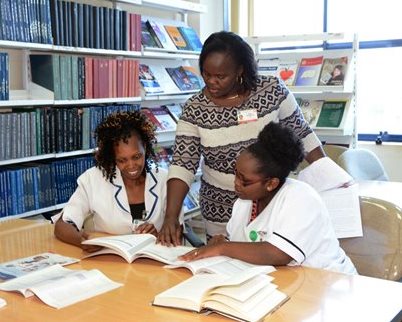Classrooms of care: connecting with students in an oncology nursing diploma programme
This story is written by Diana Kassaman and Tayreez Mushani from School of Nursing and Midwifery, East Africa
Classrooms of Care establish the foundation of caring and collaborative culture among students and practitioners. Our teaching philosophy is deeply rooted in the nexus of caring and collaboration which we wanted to set as a classroom norm from the beginning of our course in the Oncology Nursing Diploma Program. We were greatly inspired by the University Chancellor's speech at the inauguration of the School of Nursing and Midwifery (SONAM) in Karachi, Pakistan where he stated,
"If you fail, I have failed, if you succeed, Pakistan will be rewarded."
We used this as a preamble in the course; and on the first day, we told our students,
"If you fail, we will have failed and if you succeed, Kenya will be rewarded because our patients will receive better care."

Classroom of care is an important milieu for an Oncology Nursing Diploma Programme where students learn to empathize with patients and families they would be working with in the hospitals. Generally, students in the program come from many different and diverse backgrounds. In our class, there was only one student who had an experience of working in an Oncology Centre and the rest of the students had little knowledge about Oncology nursing due to which some concepts were entirely new to them. Therefore, it was important for us to establish a safe class environment from the very beginning with clear instructions so that students felt comfortable in asking questions and expressing themselves whenever concepts were unclear. Moreover, during the course we fostered the elements of care and collaboration through three distinct ways:
Creating Culture of Caring Classrooms: In the diploma programme, our course classes were scheduled for two days a week. On day one of each week, we encouraged students to share their stories, songs, poems, etc. and then we reflected on them together as a whole class. To appreciate students' efforts and engagement, we also displayed some of the printable stories and poems on the bulletin board. For day two of each week, we initiated prayers in the classroom, following the guidelines of being respectful to all faiths. Both of these initiatives (i.e. reflection on students' work and prayers) established the culture, comfort and exemplified the practice that we saw all our students as equals and we cared about their learning experiences. In our class, holistic care has always been central to the learning process; therefore, we extended the concept of care beyond classroom boundaries by celebrating students' birthdays, baby showers, and reaching out to individuals who were struggling. Through this approach, we wanted to show our students that, as human beings, there will be many different moments and emotions they will experience in their nursing careers and they must adjust how they care for patients depending on these circumstances.
Valuing Students' Feedback: It is widely acknowledged that effective teaching requires one to make an effort to know one's students because in the class, there are students with diverse personalities, needs and learning styles. We believe that knowing students' strengths and weaknesses, and then planning our lessons and activities accordingly, made us more effective teachers. Therefore, on a regular basis, we would request our students to share their feedback on the course content and facilitation, and indicate areas they thought required improvement. Through this process, we learned that whilst teaching, it's important to look around and recognize when students are not following the concepts. For example, when we experienced this situation, we stepped back and asked ourselves, "How do students want us to approach this concept? Which strategy would help them to understand the concepts in an easier way"? Reflection on these questions along with students' feedback through evaluation forms helped us improve our skills as facilitators. This improvement in our teaching strategies helped students recognize that their feedback and thinking was valuable to the class and to us.
Preaching what we practice: Role modelling and awareness of your actions as a facilitator are also crucial, as students do not only learn from 'what you say' but they critically observe and learn from 'what you do'. For instance, when we go to the clinical site in the hospital, how we interacted with the staff, doctors, and patients was a key learning aspect.
Through some of these approaches, we created a caring community of learners—a community whose members feel valued, personally connected to one another, and committed to everyone's growth and learning. Towards the end of the course, it was fulfiling for us to see our students progressing through the course. They excelled in their licensing exam: out of the 16 students who sat the Nursing Council Examination, 13 students passed with distinction, and 3 with credit, placing all students within the top two levels of the examination. Furthermore, we were happy to see that prior to taking the exam, students were very confident in their abilities to succeed. We were very pleased with these results, and truly proud of their hard work.


